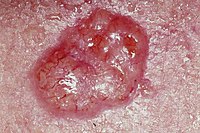
Photo from wikipedia
BackgroundNipple reconstruction in implant-based breast reconstruction remains challenging, as the remaining thin skin envelope results in a less projected neo-nipple with a reduced volume. This study presents a modified top-hat… Click to show full abstract
BackgroundNipple reconstruction in implant-based breast reconstruction remains challenging, as the remaining thin skin envelope results in a less projected neo-nipple with a reduced volume. This study presents a modified top-hat flap technique with rolled dermal grafts from the dog-ears of lateral wings for augmenting reconstructed nipples during implant-based breast reconstruction.MethodsBetween April 2011 and December 2014, among 34 patients who underwent immediate post-mastectomy reconstruction with a direct silicone implant, nipple reconstruction was performed using the modified top-hat flap technique in only 21 patients (group A), whereas 13 patients underwent the modified top-hat flap technique with rolled dermal grafts from the dog-ears of lateral wings (group B). The projection and width of the neo-nipple were measured at the time of surgery and at 1 year post-surgery, respectively.ResultsAll modified top-hat flaps were successful without any complications. The mean nipple projections at the time of surgery were 0.75 ± 0.107 cm (range 0.5–0.9 cm) and 1.29 ± 0.064 cm (range 1.2–1.4 cm) in groups A and B, respectively (p < 0.001). The mean nipple widths at the time of surgery were 0.90 ± 0.184 cm (range 0.6–1.2 cm) and 1.43 ± 0.076 cm (range 1.3–1.5 cm) in groups A and B, respectively (p < 0.001). The maintenance of nipple projection and width was significantly increased in group B compared with group A.ConclusionThe modified top-hat flap technique with rolled dermal grafts from the dog-ears of lateral wings is a useful and easy method to expand and augment the volume of reconstructed nipples in implant-based breast reconstruction.Level of Evidence IIIThis journal requires that authors assign a level of evidence to each article. For a full description of these Evidence-Based Medicine ratings, please refer to the Table of Contents or the online Instructions to Authors www.springer.com/00266.
Journal Title: Aesthetic Plastic Surgery
Year Published: 2017
Link to full text (if available)
Share on Social Media: Sign Up to like & get
recommendations!